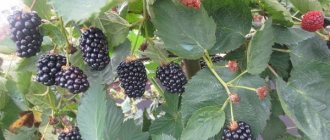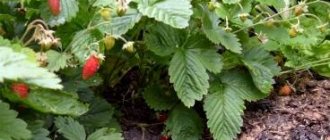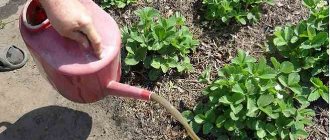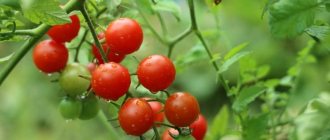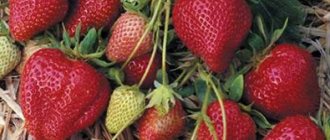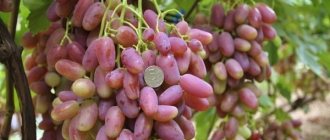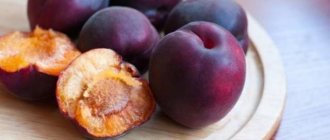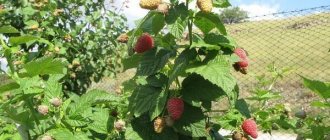History of selection
Loch Ness blackberries are one of the most popular industrial varieties in Europe and America. It was created in 1990 in the UK by Dr. Derek Jennings. Lochness is a complex hybrid, the parent crops of which are European varieties of blackberries, raspberries and Logan berries.
It was Derek Jennings who isolated the L1 raspberry gene responsible for large fruit, thanks to which Loch Ness blackberries are large in size.
Comment! The Lochness variety received an award from the Royal Society of Horticulturalists of Britain for a combination of positive qualities, including large fruit and productivity.
Description of the berry crop
First of all, Loch Ness blackberries are a very good commercial variety. It is not a dessert, although the berries are large and the taste is pleasant. This should not be forgotten by those gardeners who criticize the Loch Ness variety for its low tasting score and excessive density of berries.
General idea of the variety
Loch Ness blackberry forms a powerful compact bush with thornless shoots up to 4 meters high. The variety is classified as semi-erect - the vines grow straight at first, then become thinner and bend towards the ground.
The shoots of the thornless Loch Ness blackberry variety grow quickly and form many lateral branches and fruit branches. The root system is powerful. The leaves are serrated, medium-sized, bright green.
The variety produces a lot of replacement shoots, and if the roots are intentionally damaged, it produces enough growth. Fruiting occurs on last year's canes. The load on the bush is large, although not as heavy as that of the Natchez blackberry.
Berries
The berries of the Loch Ness blackberry are large, glossy black, elliptical in shape, and very beautiful. In many sources you can read that the fruits of the variety are one-dimensional. This point needs clarification. Loch Ness produces leveled berries from harvest to harvest. The first fruiting brings the largest blackberries - up to 10 g each. Subsequently, the average weight of the berries is 4-5 g. The fruits are collected in large clusters.
Loch Ness blackberries don't taste the best. At least, gourmets and experts are not delighted - they rated it 3.7 points. People's connoisseurs even gave the variety 2.7 points. Perhaps they tasted Loch Ness blackberries at the stage of technical ripeness - the degree of ripeness of its berries is difficult to determine by eye. The greenish berry is slightly sour. Fully ripe – sweet, with pronounced sourness, pleasant to the taste, aromatic.
Loch Ness blackberries are dense but juicy, with small seeds. They tolerate transportation well and are suitable for mechanized harvesting.
Reviews from gardeners about the Loch Ness variety
The variety was obtained by Jennings at SCRI England in 1990. The variety was created on the basis of European species of blackberries, loganberries and raspberries. The bushes are semi-creeping, compact, long thornless shoots - more than 4 m. The berries with an average weight of 4 g are one-dimensional, black, shiny, dense, transportability is very high. The berry is tasty and aromatic. Ripens in August. If the head of the bush is damaged, it produces thornless shoots. Suitable for fresh consumption and processing. This is official data. I will add on my own behalf. My berry is much larger than 4 g, at the same level as Smutsem, sweeter than Thornfree’s and the seeds are much smaller. Requires shelter for the winter. The productivity is very high, the fruits are multi-berry like Thornfree. It reproduces well by rooting the tops. One of the leading varieties in the world
Characteristic
Loch Ness blackberries are one of the best bred to date, if we consider the variety as an industrial crop (which it is).
Main advantages
The Loch Ness variety has good resistance to drought and can withstand frosts down to -17-20⁰ C. This means that blackberries need to be covered in all regions except the southernmost ones.
The description of the Loch Ness blackberry variety as one of the most unpretentious is true. But with sufficient care, its berries become tastier, and the harvest can almost double – from 15 to 25, or even 30 kg per bush.
The variety is undemanding to soil and can grow in all Russian regions. Loch Ness blackberries are popular in the central zone; they are often planted in the Moscow region.
There are no thorns on the shoots, which makes maintenance much easier. The berries are dense, transport well, and are suitable for mechanized and manual harvesting.
Flowering period and ripening time
Loch Ness blackberries are a mid-late variety. It blooms at the beginning of summer, ripens by the end of July in Ukraine and southern Russia, in the central zone - 10-14 days later.
Fruiting is extended, but not excessively - 4-6 weeks. In most regions, the berries have time to ripen before frost.
Yield indicators, fruiting dates
The Loch Ness variety is one of the most productive. Even with poor agricultural technology, an adult bush produces about 15 kg of berries. The average with minimal care is 20-25 kg per plant. With intensive agricultural technology, it is quite possible to collect up to 30 kg from each Loch Ness blackberry bush.
The first berries appear in the second year after planting; the third season is considered the time of entry into full fruiting. But blackberries will produce 25-30 kg per bush even later. The Loch Ness variety is distinguished by a powerful root system, as it grows, the yield increases.
Area of application of berries
Loch Ness blackberries are not considered dessert berries, but if picked at full ripeness, the taste will be pleasant. The fruits of this variety are perfect for freezing and all types of processing. Despite the large size of the berries, they can be dried.
Resistance to diseases and pests
Like the entire crop as a whole, Loch Ness blackberries are resistant to pests and diseases. True, treatments for preventive purposes need to be carried out.
Advantages and disadvantages
The description of the Loch Ness blackberry variety shows that as an industrial crop it is close to ideal. But it does not differ in dessert taste, and is more suitable for processing than consuming fresh berries.
The undoubted advantages of the variety include:
- High yield - up to 30 kg with intensive care.
- The berries are large and beautiful.
- The bush forms many replacement shoots.
- The lashes grow quickly, with a large number of side branches.
- The fruits are dense and transport well.
- Mechanized harvesting is possible.
- Processed products are of high quality.
- The shoots are thornless.
- It is not necessary to trim the lashes.
- High resistance to adverse weather conditions, diseases, and pests.
- Undemanding to soil composition.
- Ease of propagation of the variety.
Among the shortcomings we note:
- Mediocre fruit taste.
- Mid-late berry ripening period.
- The variety needs to be covered for the winter.
- In rainy or cold summers, as well as when planted in the shade, the berries gain little sugar.
- The Loch Ness variety contains little vitamin C compared to other blackberries.
Beneficial features
A description of blackberries, both Loch Ness and other varieties, would be incomplete without indicating their benefits, which are as follows:
- the berry contains many different vitamins and microelements;
- it contains biologically active substances that strengthen capillaries and treat inflammation;
- a decoction of leaves and fruits helps with high temperatures - promotes sweating, from the roots - helps with sore throat;
- ripe fruits help against constipation, unripe fruits help against diarrhea;
- leaves and berry juice are good for the skin.
The Loch Ness variety is one of the optimal varieties for planting in the country: the agricultural technology for caring for it is simple, it does not need to be closed for the winter, the harvest is always plentiful, and the berries are not only tasty, but also healthy.
Reproduction methods
Loch Ness blackberries are easy to propagate by pulping (rooting the tops) and layering. When the root system is deliberately injured with a spade bayonet, the bush produces a lot of growth.
You shouldn't expect anything good from sowing seeds. Loch Ness blackberries are a complex hybrid. Seedlings will be of interest only to breeders when creating new varieties.
Propagation by root cuttings will give good results. But in private households there is no point in resorting to this method. It is much easier to get several or even a dozen new plants by dropping cuttings or from shoots.
Landing rules
Loch Ness blackberries are planted in the same way as other varieties. There is nothing complicated about this; the crop takes root well if you choose the right time, place, and water regularly at first.
Recommended timing
Blackberries should be planted in the spring, after warm weather has set in and the ground has warmed up. The plant will then have time to take root before the cold weather.
In the south, planting is carried out in the fall, no later than a month before the onset of frost. Spring planting there is undesirable - warm weather can quickly give way to heat, which will destroy the blackberries that have not had time to take root.
Choosing a suitable location
A well-lit place, necessarily protected from the cold wind, is suitable for planting the crop. Groundwater should not approach the surface closer than 1-1.5 m.
The Loch Ness variety is undemanding in terms of soil composition, but it cannot be planted on sandstones. But light loams rich in organic matter are ideal.
Blackberries should not be planted close to raspberries, nightshades or strawberries.
Soil preparation
A planting hole for Loch Ness blackberries is dug with a diameter of 50 cm and the same depth, the top layer of soil is set aside - it will be useful for preparing a fertile mixture. To do this, the soil is mixed with a bucket of humus, 50 g of potash and 150 g of phosphate fertilizers. You can add dolomite flour or crushed or ground eggshells (a source of calcium).
Sand is added to dense soils, and an additional dose of organic matter is added to carbonate soils. The soil for blackberries should be slightly acidic (5.7-6.5); if the pH level is lower, add dolomite flour or chalk; above that, red peat.
The planting hole is filled 2/3 with the prepared mixture, filled with water, and allowed to settle for at least 10-15 days.
Comment! Although Loch Ness blackberries are undemanding to the soil, planting them in fertile soil enriched with additives will ensure a good harvest, large berries, and the bush will take root faster and better.
Selection and preparation of seedlings
Seedlings must be purchased from a trusted place. The Loch Ness variety is not one of the newest, but is quite in demand, and farms often purchase it. So:
- You need a lot of seedlings.
- In the total mass it is easy to slip in unsuitable planting material or an unclaimed variety.
So make sure that there are no thorns on the shoots (the Loch Ness thornless variety), and that they themselves are flexible, with smooth, intact bark. A distinctive feature of blackberries is their powerful root system. In the Loch Ness variety it is better developed than in other representatives of the crop. Take the time to smell the root – the smell should be fresh.
Algorithm and landing scheme
The recommended planting pattern for Loch Ness blackberries is 2.2-3 m between bushes, the rows should be 2.5-3 m apart. Compaction on industrial plantations to 1.8-2 m is acceptable. But the distance between rows during mechanized harvesting is a minimum distance of 3 m must be maintained.
Planting blackberries:
- A small hill is made in the center of the planting hole, around which the roots are straightened.
- The fertile mixture is added gradually, constantly compacting it carefully to prevent the formation of voids, but not to damage the roots. The neck is deepened by 1.5-2 cm.
- After planting, blackberries are watered abundantly. This will require at least a bucket of water.
- The soil under the bush is mulched with humus or acidic (high-moor) peat.
Preparing for frost
The winter hardiness of Loch Ness is very high, which distinguishes it from most varieties of garden blackberries. However, so that it always bears fruit, it can also be covered for the winter, especially since only well-ripened shoots are resistant, and the rest may suffer. And even healthy shoots can freeze at -20ºC and below. To do this, you need to lay the plant on the ground (along with a trellis, so as not to damage it), put peat, leaves or sawdust on it, put plastic film on top, and when snow falls, do not remove it. Since this variety is semi-creeping, the shoots may break when tilted, so you should first tie a load to them so that they begin to bend toward the ground.
There is also an option to remove them from the supports so that they droop. With the onset of frost, shoots (of different varieties) should be placed on boards, pinned, sprayed with copper sulfate to prevent possible pests and covered with straw.
In order to fully prepare any varieties of blackberries for the cold, for the winter, at the end of August you need to stop watering them; autumn pruning is required.
Loch Ness, like any other variety, will survive the winter well with proper care:
- regular watering;
- feeding;
- thinning and shaping of bushes;
- garter to the trellis;
- weeding and digging up the soil.
For winter shelter it is best to use:
- corn leaves, which are then covered with plastic wrap;
- sawdust;
- roofing felt;
- hay;
- straw;
- humus;
- vegetable tops.
Warming for the winter is an important part of berry care that should not be neglected.
Subsequent care of the crop
Growing Loch Ness blackberries will not be difficult either for novice gardeners or on industrial plantations. The main thing is that the seedling takes root well, and for this you need to follow the planting deadlines and water the bush abundantly.
Growing principles
Loch Ness blackberries need to be tied to a support. You can use any one - multi-row, T or V-shaped, up to 2.5 m high. The shoots are fastened with a fan, zigzag, braided, side branches are placed parallel to the ground. To avoid confusion, it is better to spread the fruiting canes and young ones in different directions.
Anyone who keeps Loch Ness blackberries for garden decoration, and is not too concerned about the size of the crop, can prune the shoots as soon as they stop growing straight and begin to droop towards the ground. This way the variety will not need to be tied up at all. You will get a decorative bush from spring to autumn, however, you won’t even collect 15 kg of berries from it.
To get 25-30 kg of berries from Lochness blackberries, you need intensive feeding and regular pruning.
Necessary activities
Plants must be watered. Blackberries are all moisture-loving; the resistance to drought stated in the description means one thing - this particular variety needs less water than others. So, in the absence of rain, water the bush at least once a week; if the weather is hot, a little less often in cool summers.
To retain moisture, provide additional nutrition and protect the root system from high temperatures, mulch the soil. If you don't have humus or acidic peat, use straw or grass. As a last resort, you can cover the soil with pulled out weeds (just make sure that there are no seeds on it, otherwise you will have additional problems with weeding).
The Loch Ness variety is overloaded with berries and therefore requires intensive feeding. In the spring, immediately after raising the vines onto the trellis, the soil is fertilized with nitrogen (it is better to take calcium nitrate). During the period of flowering and berry setting, a complete mineral complex that does not contain chlorine is used. During the ripening of berries, foliar feeding with the addition of humate and chelates, and root feeding with a solution of mullein or grass infusion are useful. In early autumn, potassium monophosphate is used.
The soil around the blackberry bushes is loosened in spring and autumn, and covered with mulch during the season of active growth and fruiting.
Shrub pruning
Fruit-bearing shoots should be cut off at ground level in the fall. Be sure to remove all broken, weak and diseased lashes.
Otherwise, pruning Loch Ness blackberries is a delicate matter, and causes a lot of controversy among gardeners. Shortening the tops of the main canes makes maintenance easier and increases lateral branching. But it is already strong. If you thicken the bush, it will be so overloaded with berries that no amount of fertilizing will help.
But it’s worth shortening the side shoots - this way there will be fewer berries, but they will become larger. As a result, the total harvest will not be affected.
Young canes are rationed - in the spring, 6-8 of the most powerful ones, which have wintered well, are left for fruiting, the rest are cut out.
Preparing for winter
In autumn, Loch Ness blackberries are carefully removed from their supports (along with the wire). The branches that bear fruit are removed, the young ones are laid on the ground, pinned down, covered with dry corn stalks, spruce branches, and straw. Spunbond or agrofibre is laid on top.
